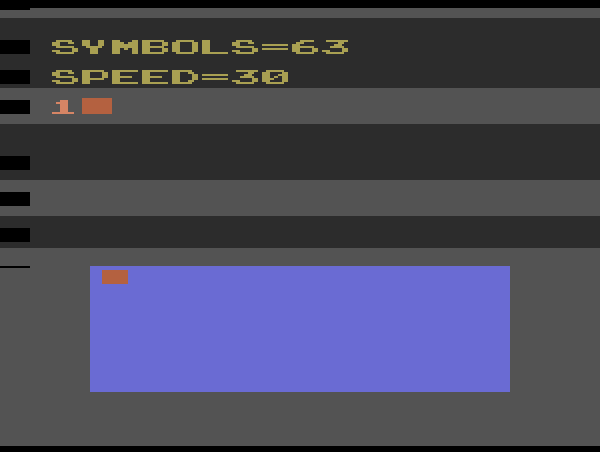Basic Programming
type: edutainment
perspective: other fixed camera
player options: single player
languages: eng other
perspective: other fixed camera
player options: single player
languages: eng other
2.3/5


Description
A Programming IDE for a BASIC-like language. Pong as source code is an included game.
An historically significant title. An Atari VCS & this game cart were cheaper than a computer thus an introduction to programming was made widely available to whoever was interested learning how to create their own games (or applications). Some programmers that grew up in the early 80s got their first programming experience using this product.
It doesn't really teach BASIC so much as it teaches how some aspects of programs work. The computer language used superficially resembles BASIC but has some similarities to assembly language; though it is not either. More impressive than the language is the interface. It really is a rudimentary IDE. There are 6 'regions' to the interface that are expanded or hidden as needed. Sizing was done automatically to facilitate the current task. The user had control for manually showing or hiding the individual regions. (This was before GUI. Today this arrangement might be called stacked tiled hide-able frames). The program's execution or lack thereof is unaffected by the view of regions (multitasking! On the VCS!). The regions are, Program, Stack, Variables, Output, Status, and Graphics. Program is where the user actually entered and saw their application's code. Stack showed what the program was doing as it ran (it stepped through the program at the rate determined by a SPEED value). Variables is a watch list that displays all variables and their current values. Output is the ext display that programs can manipulated and show; this is where you see the text of the game. Status shows just home much resources of the poor VCS are left available and the current execution speed. Graphics is where two sprites can be manipulated and shown (this is where you see the graphics of the game).
Applications could mathematically and logically manipulate and compare variables, do if..then..else statements, print text, move the sprites. Several sample applications are included in the manual. The most impressive of which is Pong with sound.
Uses a very innovative interlaced display mode for text display.
 (Zerothis) - # 2006
(Zerothis) - # 2006
An historically significant title. An Atari VCS & this game cart were cheaper than a computer thus an introduction to programming was made widely available to whoever was interested learning how to create their own games (or applications). Some programmers that grew up in the early 80s got their first programming experience using this product.
It doesn't really teach BASIC so much as it teaches how some aspects of programs work. The computer language used superficially resembles BASIC but has some similarities to assembly language; though it is not either. More impressive than the language is the interface. It really is a rudimentary IDE. There are 6 'regions' to the interface that are expanded or hidden as needed. Sizing was done automatically to facilitate the current task. The user had control for manually showing or hiding the individual regions. (This was before GUI. Today this arrangement might be called stacked tiled hide-able frames). The program's execution or lack thereof is unaffected by the view of regions (multitasking! On the VCS!). The regions are, Program, Stack, Variables, Output, Status, and Graphics. Program is where the user actually entered and saw their application's code. Stack showed what the program was doing as it ran (it stepped through the program at the rate determined by a SPEED value). Variables is a watch list that displays all variables and their current values. Output is the ext display that programs can manipulated and show; this is where you see the text of the game. Status shows just home much resources of the poor VCS are left available and the current execution speed. Graphics is where two sprites can be manipulated and shown (this is where you see the graphics of the game).
Applications could mathematically and logically manipulate and compare variables, do if..then..else statements, print text, move the sprites. Several sample applications are included in the manual. The most impressive of which is Pong with sound.
Uses a very innovative interlaced display mode for text display.
Technical specs
display: raster
Editor note
Authors / Staff
Tags (11)
other
hardware
software
activities
Xrefs (2)
Related games
Contributors (3)
zerothis
Sanguine
Becoro
Sanguine
Becoro
Rate and review
LIKE
-
PLAYED
2
FINISHED
1
OWN
PLAYING
1
WANT


 Post an anonymous comment / review about this game
Post an anonymous comment / review about this game
